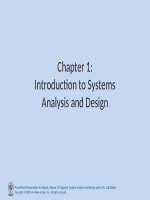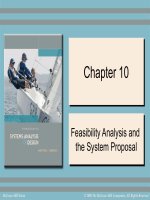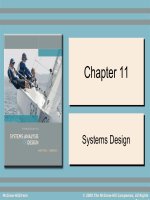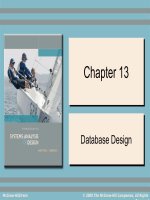Lecture Introduction to systems analysis and design Chapter 6 Whitten, Bentley
Bạn đang xem bản rút gọn của tài liệu. Xem và tải ngay bản đầy đủ của tài liệu tại đây (1.67 MB, 35 trang )
Chapter
Chapter 66
Modeling
Modeling System
System
Requirements
Requirements with
with Use
Use
Cases
Cases
McGraw-Hill/Irwin
© 2008 The McGraw-Hill Companies, All Rights
Objectives
• Describe the benefits of use-case modeling.
• Define actors and use cases and be able to identify
them from context diagrams and other sources.
• Describe the relationships that can appear on a usecase model diagram.
• Describe the steps for preparing a use-case model.
• Describe how to construct a use-case model diagram.
• Describe the various sections of a use-case narrative
and be able to prepare one.
• Define the purpose of the use-case ranking and priority
matrix and the use-case dependency diagram.
6-2
An Introduction to
Use-Case Modeling
• One of the primary challenges is the ability to
elicit the correct and necessary system
requirements from the stakeholders and
specify them in a manner understandable to
them so those requirements can be verified
and validated.
6-3
IS Development Project
Track Record
canceled
before
completion
6-4
Over budget,
late, or without
needed features
Source: The Standish Group International, Inc., “Chaos: A Recipe for Success”
User-Centered Development
and Use-Case Modeling
User-centered development – a process of
systems development based on understanding
the needs of the stakeholders and the reasons
why the system should be developed.
Use-case modeling – the process of modeling
a system’s functions in terms of business
events, who initiated the events, and how the
system responds to those events.
6-5
System Concepts for
Use-Case Modeling
Use case – a behaviorally related sequence of steps
(scenario), both automated and manual, for the purpose
of completing a single business task.
– Description of system functions from the perspective of external
users in terminology they understand.
Use-case diagram – a diagram that depicts the
interactions between the system and external systems
and users.
– graphically describes who will use the system and in what ways
the user expects to interact with the system.
6-6
Use-case narrative – a textual description of the
business event and how the user will interact with the
system to accomplish the task.
Sample Use-Case Model
Diagram
6-7
Basic Use-Case Symbols
Use case – subset of the overall system functionality
– Represented by a horizontal ellipse with name
of use case above, below, or inside the ellipse.
Actor – anyone or anything that needs to interact
with the system to exchange information.
– human, organization, another information system,
external device, even time.
Temporal event – a system event triggered by time.
– The actor is time.
6-8
Four Types of Actors
• Primary business actor
– The stakeholder that primarily benefits from the execution of
the use case.
– e.g. the employee receiving the paycheck
• Primary system actor
– The stakeholder that directly interfaces with the system to
initiate or trigger the business or system event.
– e.g. the bank teller entering deposit information
• External server actor
– The stakeholder that responds to a request from the use case.
– e.g. the credit bureau authorizing a credit card charge
• External receiver actor
6-9
– The stakeholder that is not the primary actor but receives
something of value from the use case.
– e.g. the warehouse receiving a packing slip
Use Case Association
Relationship
Association – a relationship between an actor and a
use case in which an interaction occurs between them.
– Association modeled as a solid line connecting the actor and the
use case.
– Association with an arrowhead touching the use case indicates
that the use case was initiated by the actor. (1)
– Association lacking arrowhead indicates a receiver actor. (2)
– Associations may be bidirectional or unidirectional.
6-10
Use Case Extends Relationship
Extension use case –use case consisting of steps
extracted from another use case to simplify the original.
– Extends the functionality of the original use case.
– Generally not identified in the requirements phase
– Extends relationship represented as arrow beginning at the
extension use case and pointing to use case it is extending.
– Labeled <<extends>>.
6-11
Use Case Uses Relationship
Abstract use case – use case that reduces redundancy in
two or more other use cases by combining common steps
found in both.
6-12
– Available by any other use case that requires its functionality.
– Generally not identified
in requirements phase
– Relationship between
abstract use case
and use case that
uses it is called a
uses (or includes)
relationship.
– Depicted as arrow
beginning at
original use case
and pointing to
use case it is using.
– Labeled <<uses>>.
Use Case Depends On
Relationship
Depends On – use case relationship that specifies
which other use cases must be performed before the
current use case.
– Can help determine
sequence in which
use cases need to
be developed.
– Depicted as arrow
beginning at one
use case and
pointing to use case
it depends on.
– Labeled
<<depends on>>.
6-13
Use Case Inheritance
Relationship
Inheritance – a use case relationship in which the common
behavior of two actors initiating the same use case is extrapolated
and assigned to a new abstract actor to reduce redundancy.
– Other actors can inherit the interactions of the
abstract actor.
– Depicted as an arrow beginning at one
actor and pointing to the abstract actor whose
interactions the first actor inherits.
6-14
Use Case Inheritance
Relationship
6-15
The Process of Requirements
Use-Case Modeling
•
Objective is to elicit and analyze enough requirements
information to prepare a model that:
– Communicates what is required from a user
perspective.
– Is free of specific details about how system
will be implemented.
•
6-16
To effectively estimate and schedule project, may need to include
preliminary implementation assumptions.
Step 1: Identify Business Actors
• When looking for actors, ask the following
questions:
–
–
–
–
Who or what provides inputs to the system?
Who or what receives outputs from the system?
Are interfaces required to other systems?
Are there events that are automatically triggered at
a predetermined time?
– Who will maintain information in the system?
• Actors should be named with a noun or noun
phrase
6-17
Sample List of Actors
6-18
Step 2: Identify Business
Requirements Use Cases
Business Requirements Use Case - a use case created during
requirements analysis to capture the interactions between a user
and the system free of technology and implementation details.
– During requirements analysis, strive to
identify and document only the most critical,
complex, and important use cases, often
called essential use cases.
6-19
Step 2: Identify Business
Requirements Use Cases (cont.)
• When looking for use cases, ask the following
questions:
–
–
–
–
What are the main tasks of the actor?
What information does the actor need form the system?
What information does the actor provide to the system?
Does the system need to inform the actor of any changes or
events that have occurred?
– Does the actor need to inform the system of any changes or
events that have occurred?
• Use cases should be named with a verb phrase
specifying the goal of the actor (i.e. Submit
Subscription Order)
6-20
Sample Context Diagram
6-21
Sample Use-Case Glossary
6-22
continued
Sample Use-Case Glossary
(cont.)
6-23
continued
Sample Use-Case Glossary
(cont.)
6-24
Step 3: Construct Use-Case
Model Diagram
6-25









